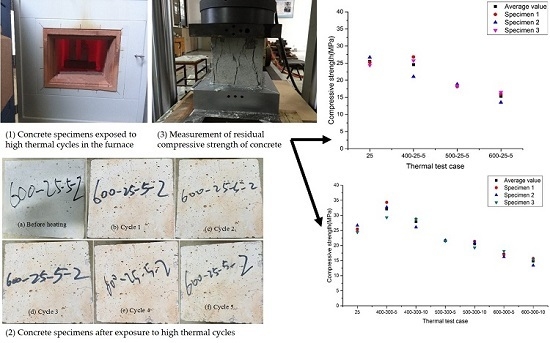Testing of High Thermal Cycling Stability of Low Strength Concrete as a Thermal Energy Storage Material
Abstract
:1. Introduction
2. Experimental Setup
2.1. Concrete Material
2.2. Experimental Strategy
3. Results and Discussion
3.1. High Temperature Tests
3.1.1. Exposure of Concrete Specimens to High Temperatures
3.1.2. Thermal Cycling between Maximal Temperature and Ambient Temperature
3.1.3. Thermal Cycling between Maximal Temperature and 300 °C
3.2. Uniaxial Compressive Tests
4. Conclusions
Acknowledgments
Author Contributions
Conflicts of Interest
References
- Gil, A.; Medrano, M.; Martorell, I.; Lázaro, A.; Dolado, P.; Zalba, B.; Cabeza, L.F. State of the art on high temperature thermal energy storage for power generation. Part 1—Concepts, materials and modellization. Renew. Sustain. Energy Rev. 2010, 14, 31–55. [Google Scholar] [CrossRef]
- Strasser, M.N.; Selvam, R.P. A cost and performance comparison of packed bed and structured thermocline thermal energy storage systems. Sol. Energy 2014, 108, 390–402. [Google Scholar] [CrossRef]
- Khare, S.; Dell’Amico, M.; Knight, C.; McGarry, S. Selection of materials for high temperature sensible energy storage. Sol. Energy Mater. Sol. C 2013, 115, 114–122. [Google Scholar] [CrossRef]
- Laing, D.; Steinmann, W.-D.; Tamme, R.; Richter, C. Solid media thermal storage for parabolic trough power plants. Sol. Energy 2006, 80, 1283–1289. [Google Scholar] [CrossRef]
- Laing, D.; Lehmann, D.; Fiß, M.; Bahl, C. Test results of concrete thermal energy storage for parabolic trough power plants. J. Sol. Energy Eng. 2009, 131, 041007. [Google Scholar] [CrossRef]
- Laing, D.; Bahl, C.; Bauer, T.; Fiss, M.; Breidenbach, N.; Hempel, M. High-temperature solid-media thermal energy storage for solar thermal power plants. Proc. IEEE 2012, 10, 516–524. [Google Scholar] [CrossRef]
- Laing, D.; Bauer, T.; Lehmann, D.; Bahl, C. Development of a thermal energy storage system for parabolic trough power plants with direct steam generation. J. Sol. Energy Eng. 2010, 132, 10111–10118. [Google Scholar] [CrossRef]
- Salomoni, V.A.; Majorana, C.E.; Giannuzzi, G.M.; Miliozzi, A.; Di Maggio, R.; Girardi, F.; Mele, D.; Lucentini, M. Thermal storage of sensible heat using concrete modules in solar power plants. Sol. Energy 2014, 103, 303–315. [Google Scholar] [CrossRef]
- Skinner, J.E.; Strasser, M.N.; Brown, B.M.; Panneer Selvam, R. Testing of high-performance concrete as a thermal energy storage medium at high temperatures. J. Sol. Energy Eng. 2013, 136, 021004. [Google Scholar] [CrossRef]
- Sakulich, A.R. Reinforced geopolymer composites for enhanced material greenness and durability. Sustain. Cities Soc. 2011, 1, 195–210. [Google Scholar] [CrossRef]
- Kong, D.L.Y.; Sanjayan, J.G.; Sagoe-Crentsil, K. Factors affecting the performance of metakaolin geopolymers exposed to elevated temperatures. J. Mater. Sci. 2007, 43, 824–831. [Google Scholar] [CrossRef]
- Shaikh, F.U.A.; Vimonsatit, V. Compressive strength of fly-ash-based geopolymer concrete at elevated temperatures. Fire Mater. 2015, 39, 174–188. [Google Scholar] [CrossRef]
- Ferone, C.; Colangelo, F.; Frattini, D.; Roviello, G.; Cioffi, R.; Maggio, R. Finite element method modeling of sensible heat thermal energy storage with innovative concretes and comparative analysis with literature benchmarks. Energies 2014, 7, 5291–5316. [Google Scholar] [CrossRef]
- Ma, Q.; Guo, R.; Zhao, Z.; Lin, Z.; He, K. Mechanical properties of concrete at high temperature—A review. Constr. Build. Mater. 2015, 93, 371–383. [Google Scholar] [CrossRef]
- John, E.; Hale, M.; Selvam, P. Concrete as a thermal energy storage medium for thermocline solar energy storage systems. Sol. Energy 2013, 96, 194–204. [Google Scholar] [CrossRef]
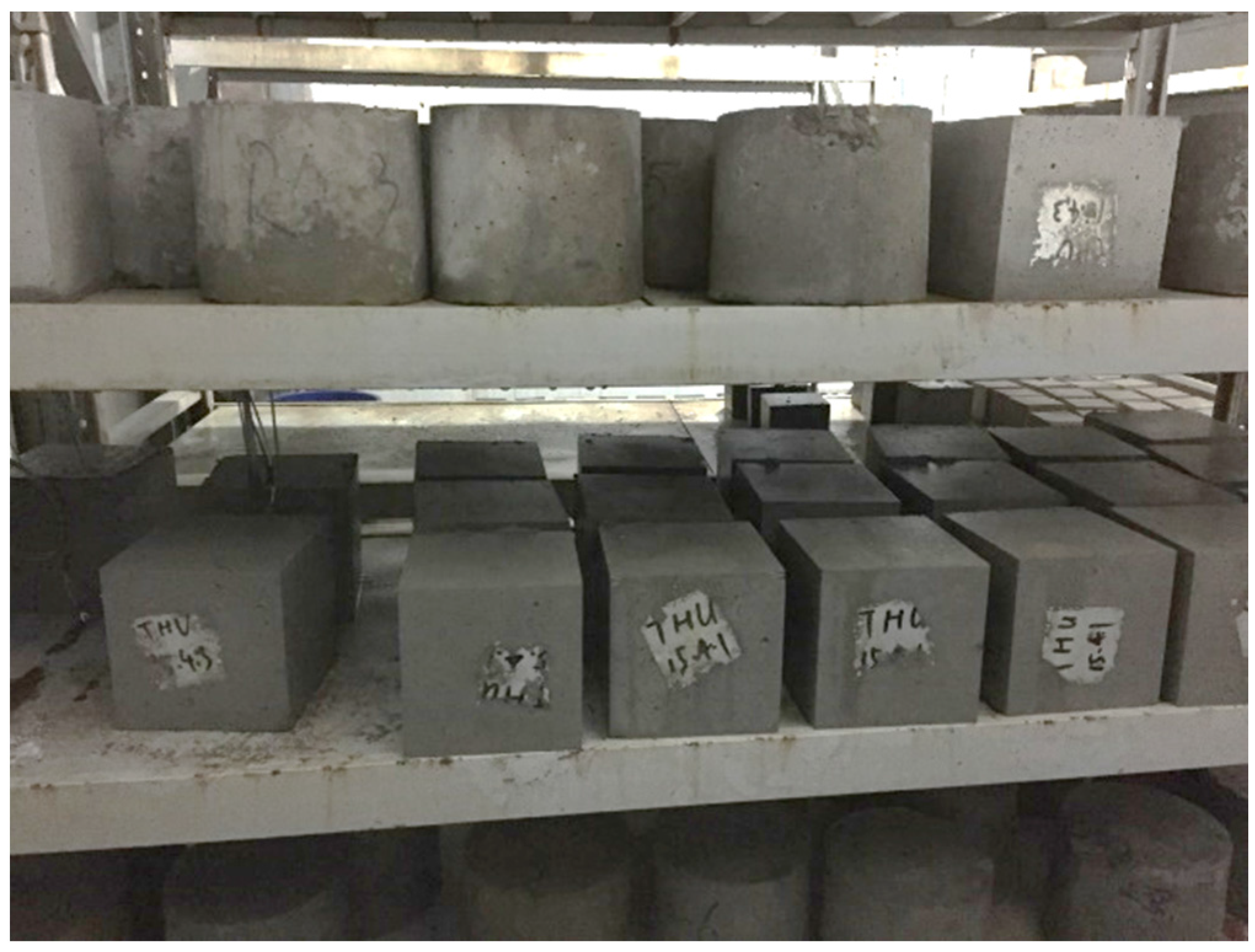
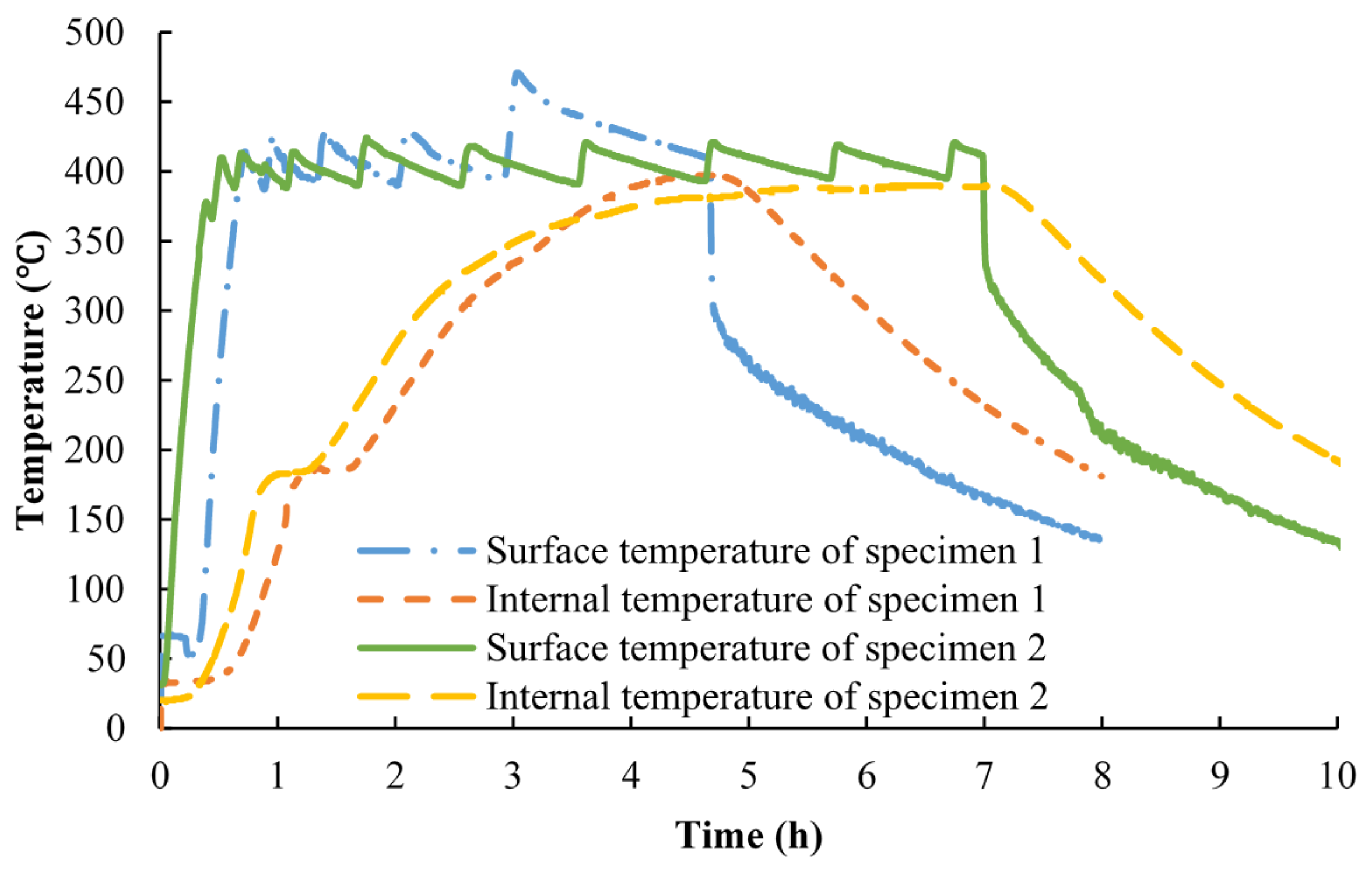
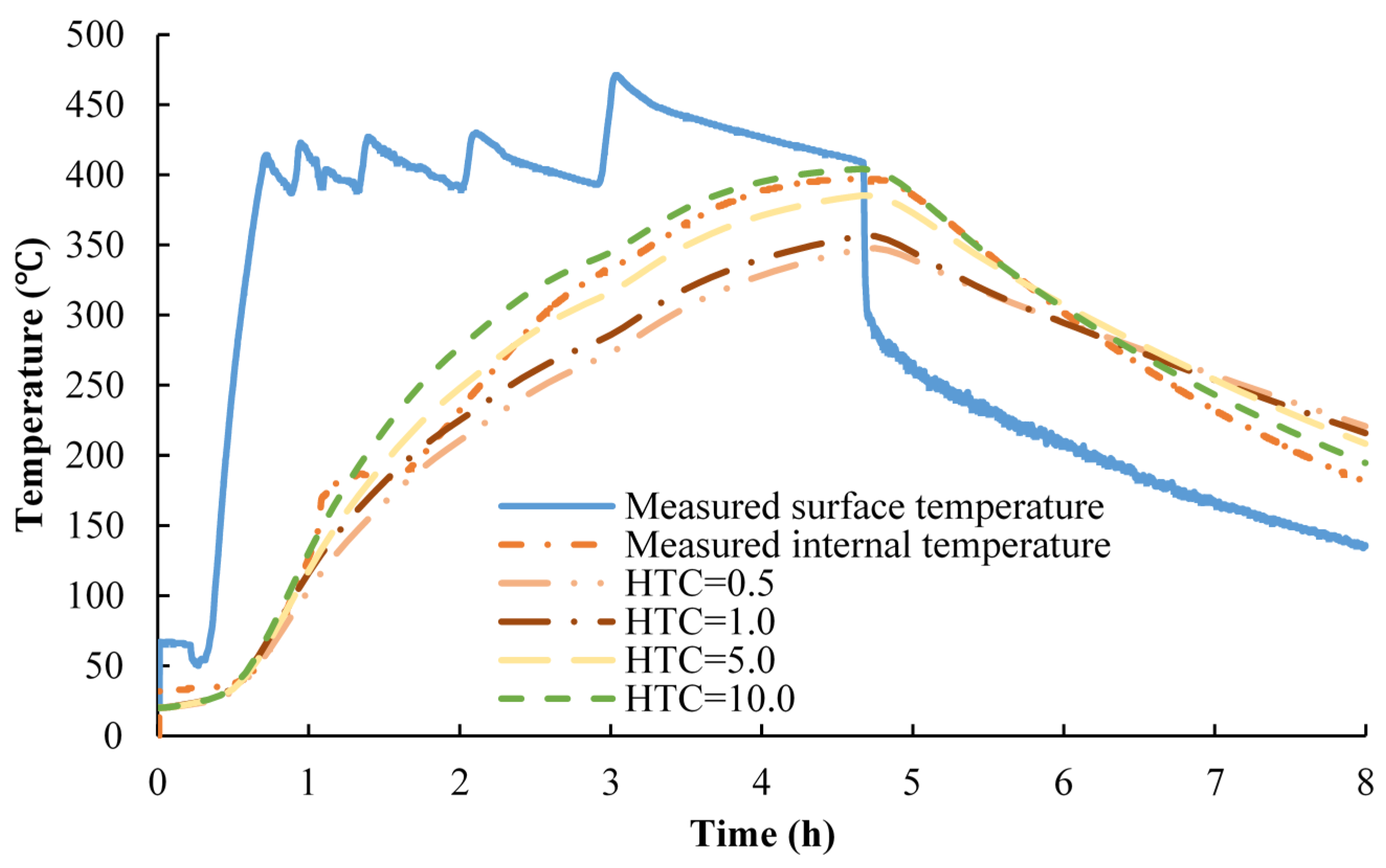
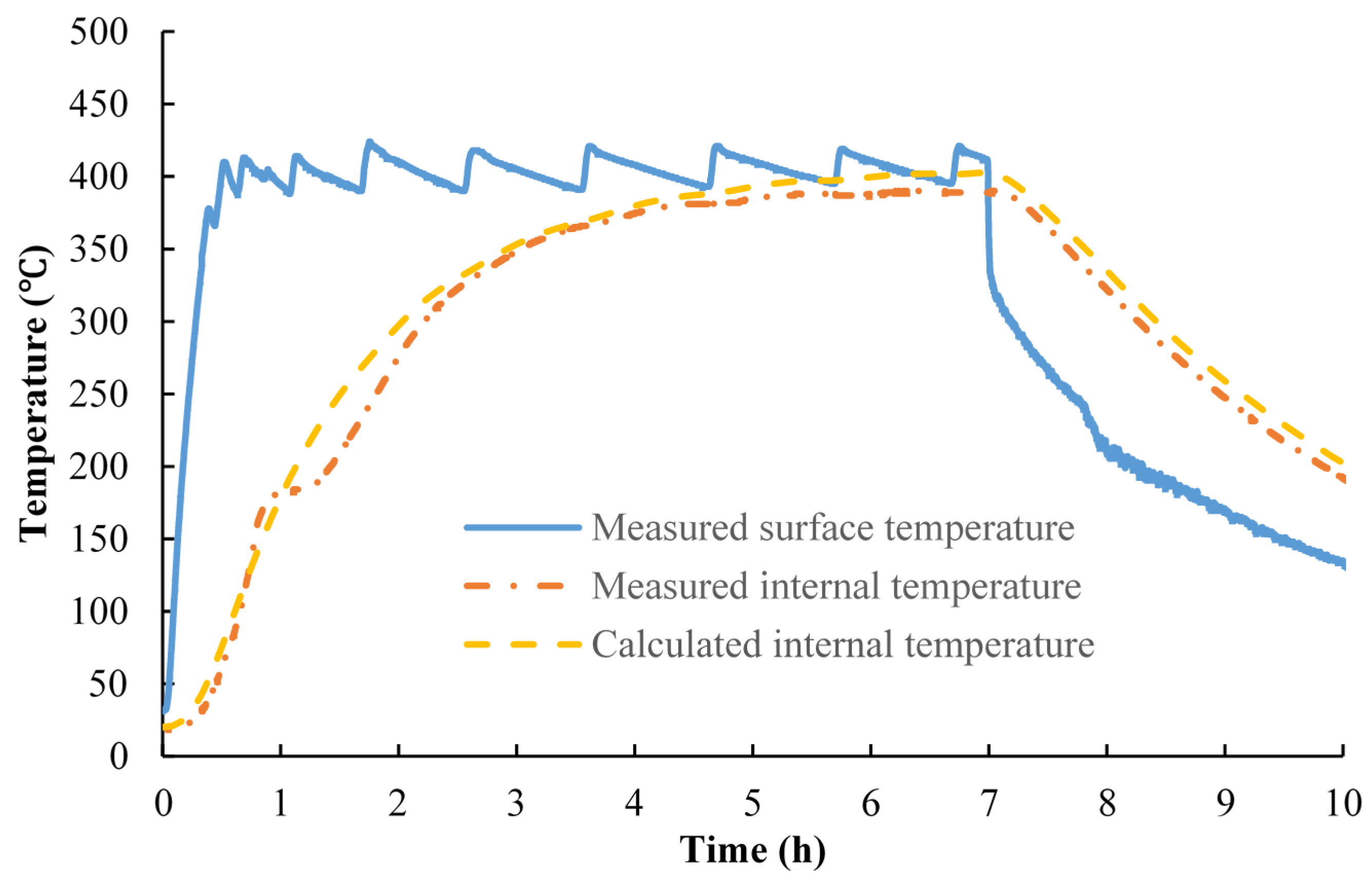
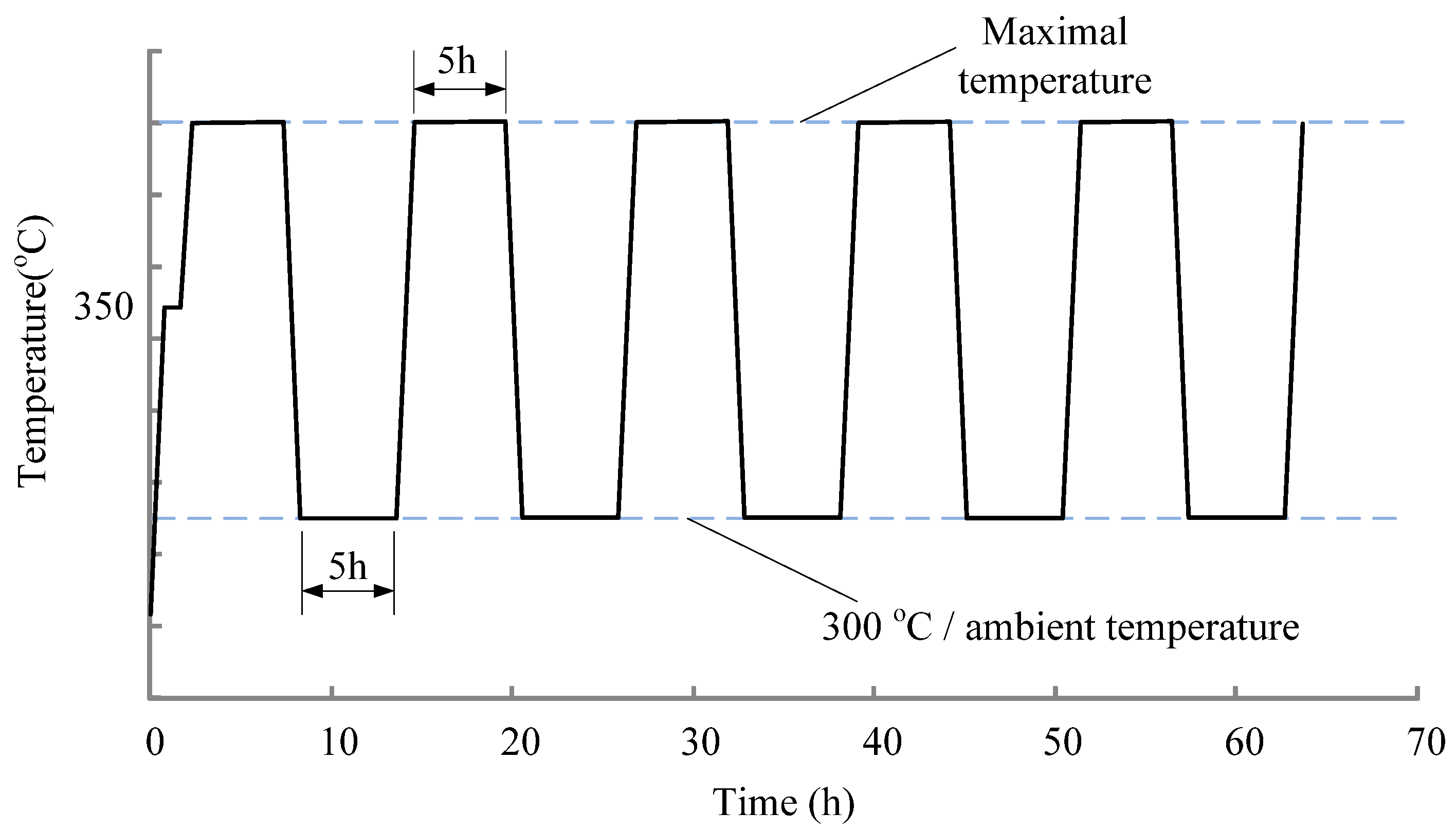

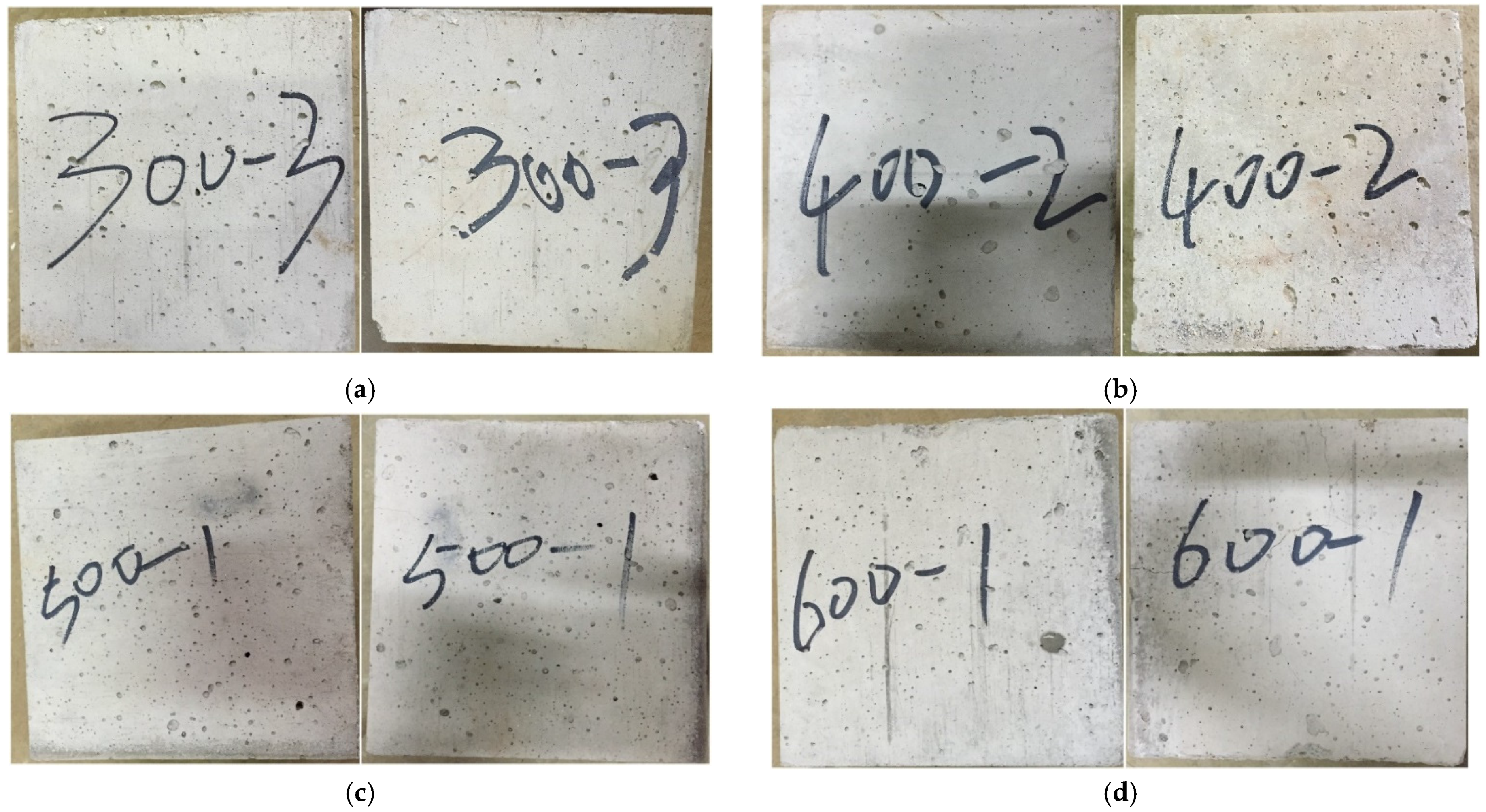
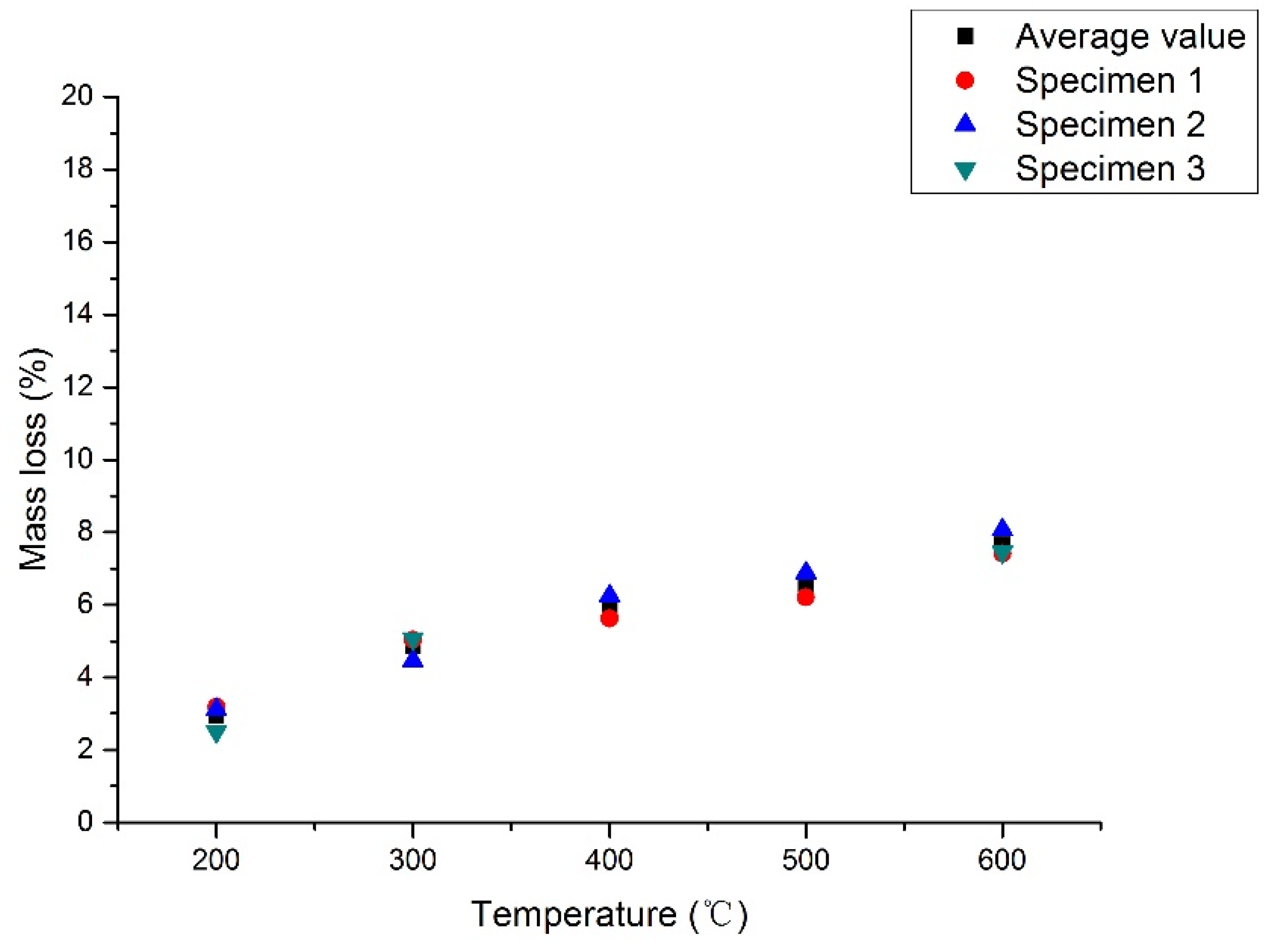



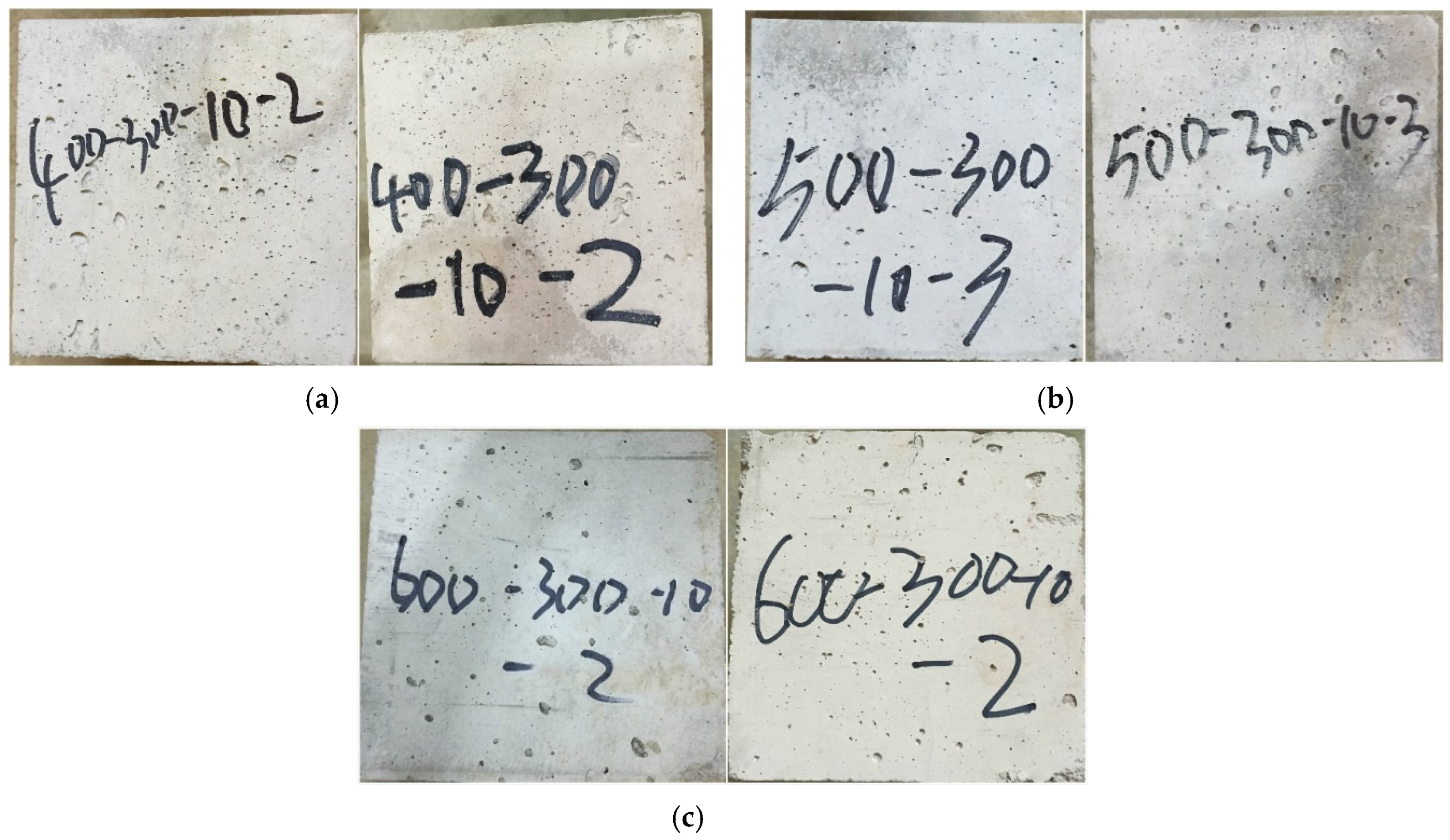
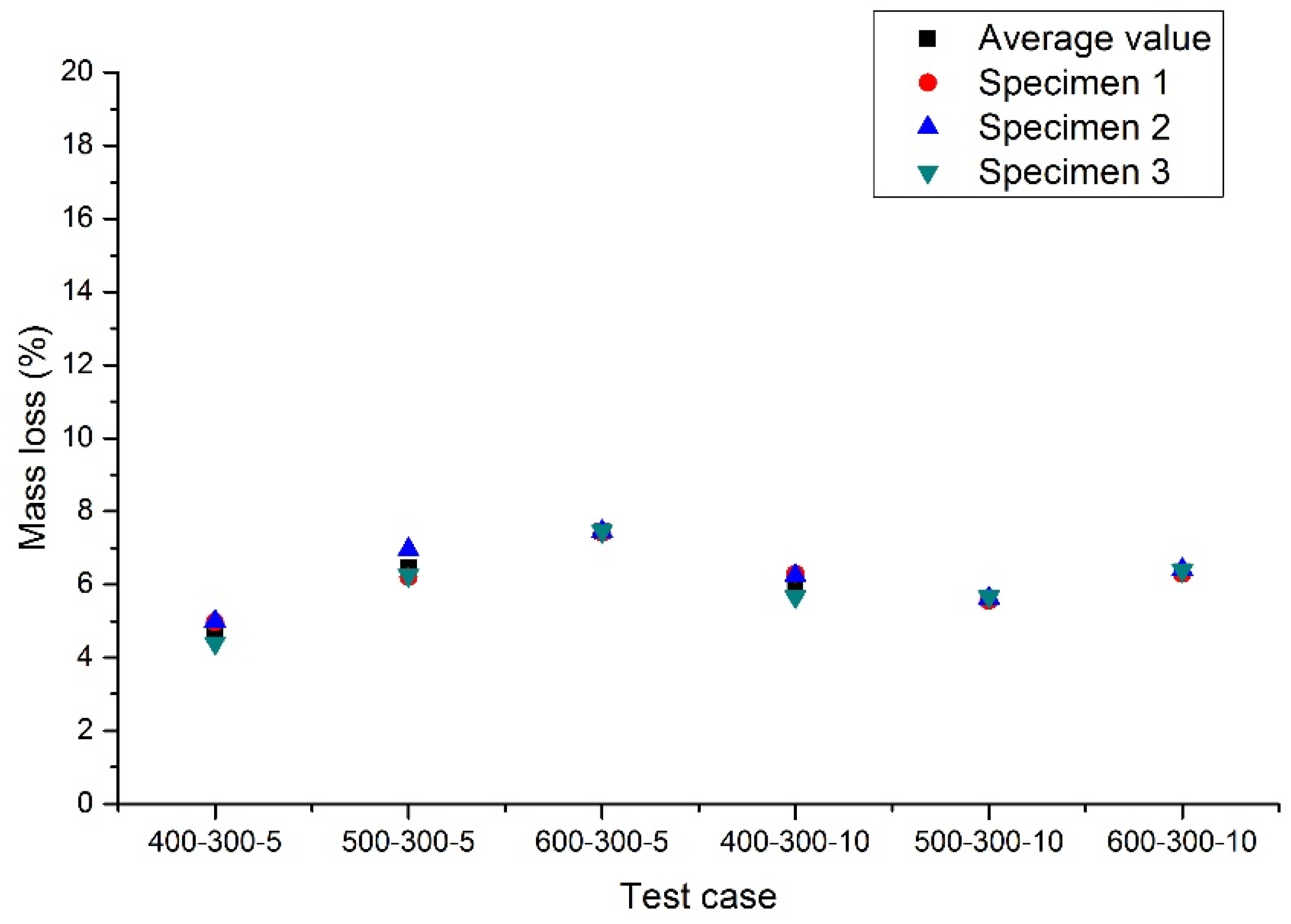
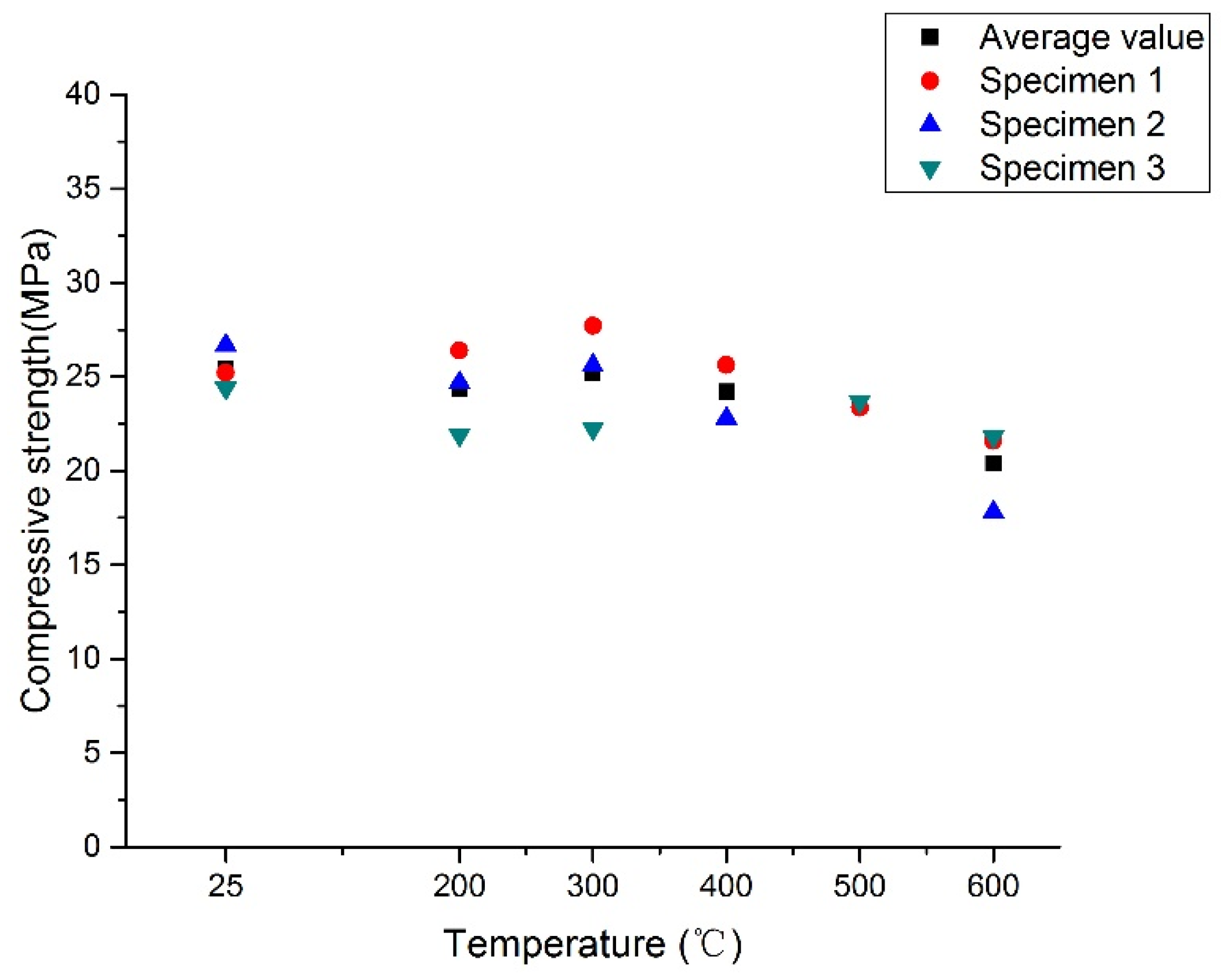
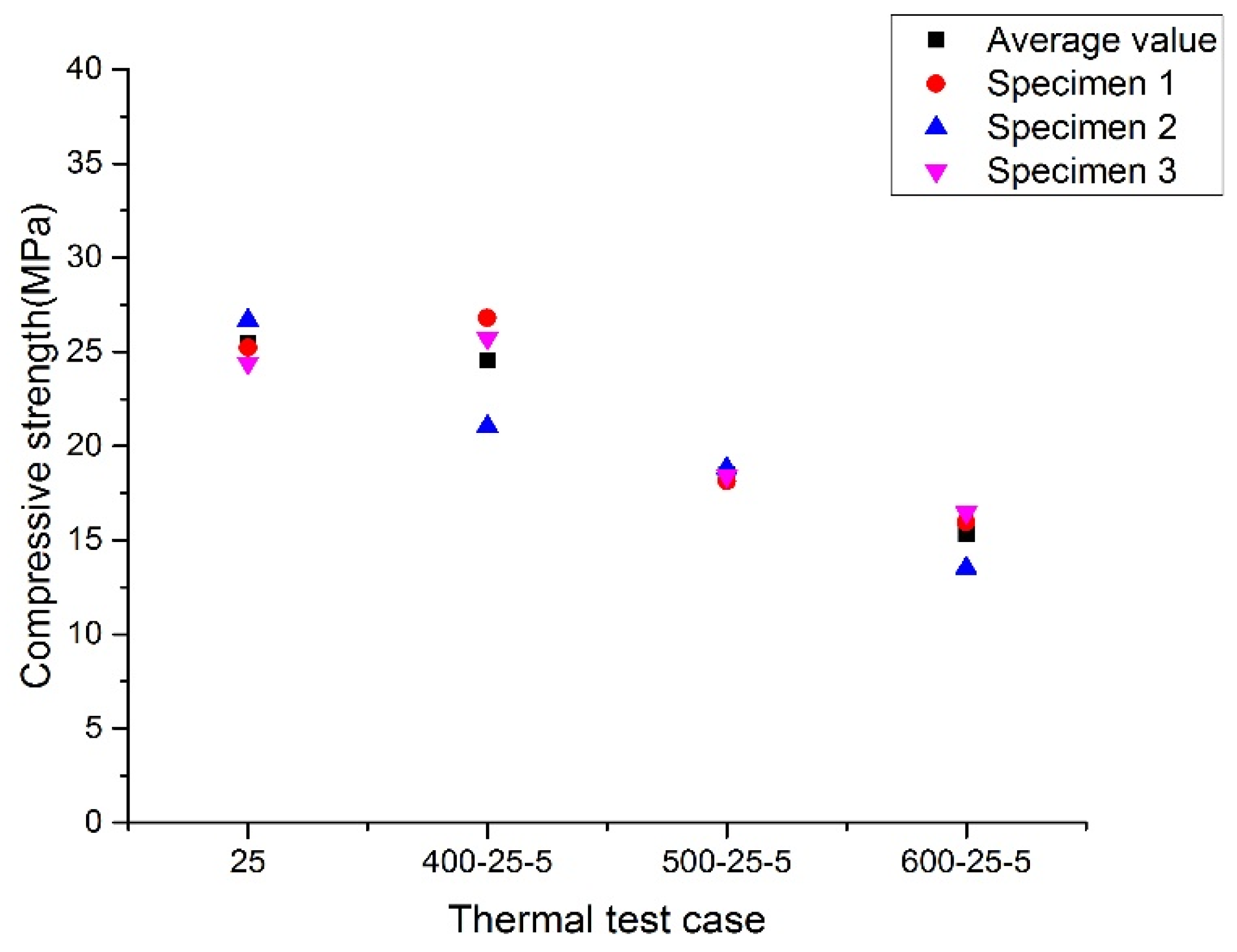
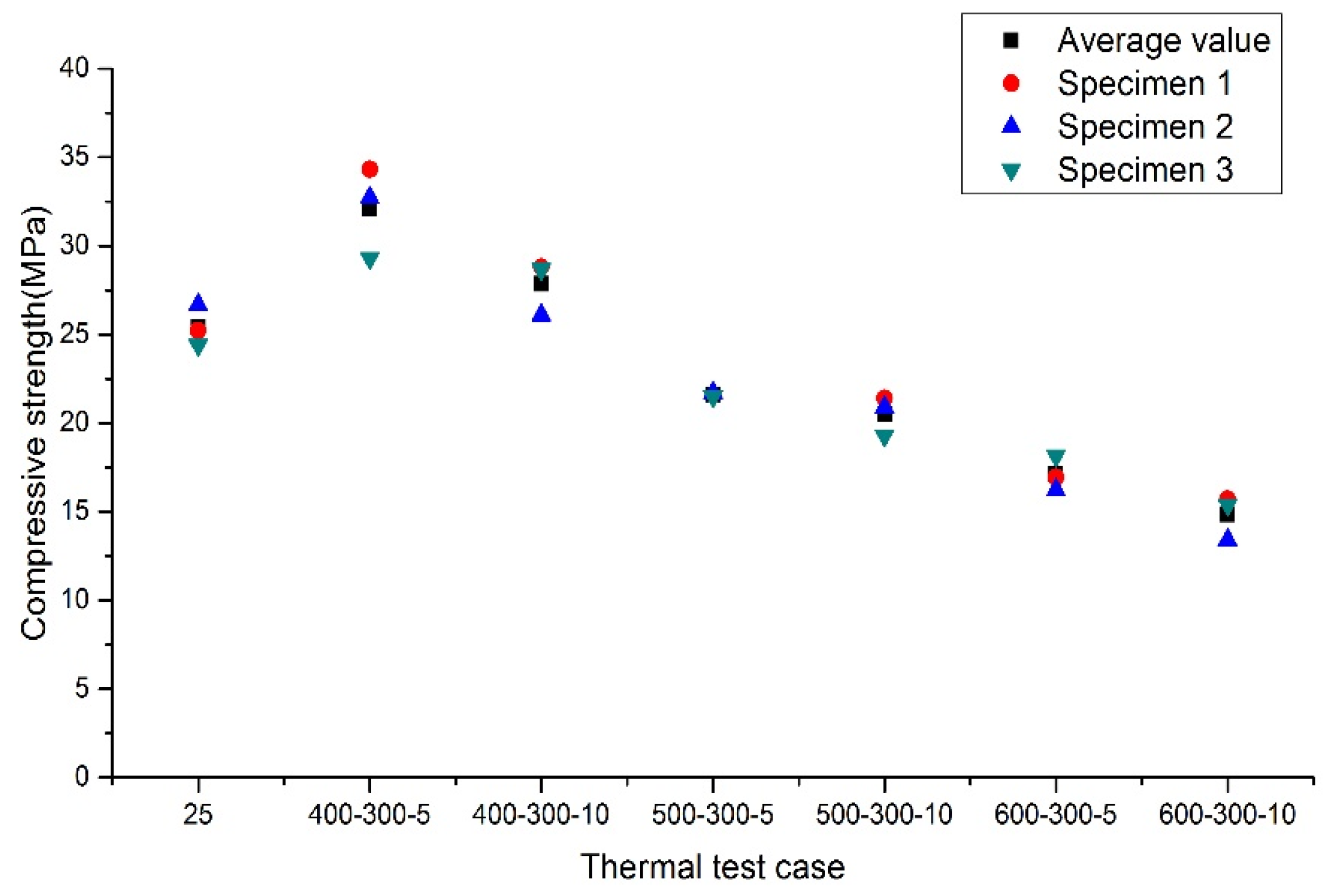
| Cement (kg/m3) | Fly Ash (kg/m3) | Fine Aggregates (kg/m3) | Coarse Aggregates (kg/m3) | Water (kg/m3) | Additive (kg/m3) | Entrained Air Content (%) |
|---|---|---|---|---|---|---|
| 210 | 160 | 996 | 849 | 170 | 2.16 | 2.1 |
| Test Cases | Maximal Temperature (°C) | Lower Temperature (°C) | Thermal Cycles |
|---|---|---|---|
| 400-300-5 1 | 400 | 300 | 5 |
| 500-300-5 | 500 | 300 | 5 |
| 600-300-5 | 600 | 300 | 5 |
| 400-300-10 | 400 | 300 | 10 |
| 500-300-10 | 500 | 300 | 10 |
| 600-300-10 | 600 | 300 | 10 |
| 400-25-5 | 400 | 25 | 5 |
| 500-25-5 | 500 | 25 | 5 |
| 600-25-5 | 600 | 25 | 5 |
| 200 °C | 200 | 25 | - |
| 300 °C | 300 | 25 | - |
| 400 °C | 400 | 25 | - |
| 500 °C | 500 | 25 | - |
| 600 °C | 600 | 25 | - |
| Heating Test Cases | Compressive Strength (MPa) | Loss Ratio (%) |
|---|---|---|
| 25 °C | 25.4 | - |
| 200 °C | 24.3 | −4.3 |
| 300 °C | 25.2 | −1 |
| 400 °C | 24.2 | −4.8 |
| 500 °C | 23.5 | −7.5 |
| 600 °C | 20.4 | −19.8 |
| 400-25-5 | 24.5 | −3.6 |
| 500-25-5 | 18.5 | −27.4 |
| 600-25-5 | 15.3 | −39.8 |
| 400-300-5 | 32.1 | 26.2 |
| 500-300-5 | 21.6 | −15.0 |
| 600-300-5 | 17.1 | −32.7 |
| 400-300-10 | 27.9 | 9.6 |
| 500-300-10 | 21.4 | −19.3 |
| 600-300-10 | 14.8 | −41.7 |
© 2016 by the authors; licensee MDPI, Basel, Switzerland. This article is an open access article distributed under the terms and conditions of the Creative Commons Attribution (CC-BY) license (http://creativecommons.org/licenses/by/4.0/).
Share and Cite
Wu, C.; Pan, J.; Zhong, W.; Jin, F. Testing of High Thermal Cycling Stability of Low Strength Concrete as a Thermal Energy Storage Material. Appl. Sci. 2016, 6, 271. https://doi.org/10.3390/app6100271
Wu C, Pan J, Zhong W, Jin F. Testing of High Thermal Cycling Stability of Low Strength Concrete as a Thermal Energy Storage Material. Applied Sciences. 2016; 6(10):271. https://doi.org/10.3390/app6100271
Chicago/Turabian StyleWu, Chao, Jianwen Pan, Wen Zhong, and Feng Jin. 2016. "Testing of High Thermal Cycling Stability of Low Strength Concrete as a Thermal Energy Storage Material" Applied Sciences 6, no. 10: 271. https://doi.org/10.3390/app6100271




